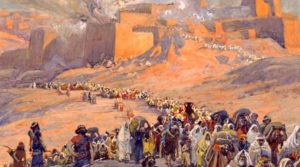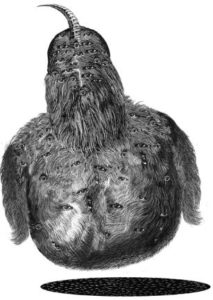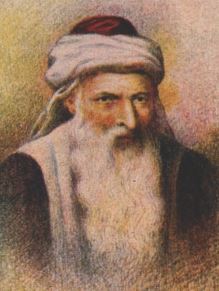In this week’s parasha, Ki Tetze, we read that “A man’s attire shall not be on a woman, nor may a man wear a woman’s garment because whoever does these is an abomination to Hashem, your God.” (Deuteronomy 22:5) In addition to the general prohibition of cross-dressing, this verse is typically used as a source for related rules such as, for example, forbidding women to wear pants, which are considered “man’s attire”. A deeper examination of the classic commentaries reveals some surprising things.
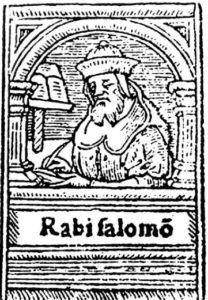
A 16th-century illustration of Rashi
Rashi (Rabbi Shlomo Itzchaki, 1040-1105) points out on this verse that cross-dressing is referring to a person who completely takes on the appearance of the opposite gender, so much so that they are able to go out among members of the opposite gender without being recognized. The ultimate purpose of this is to commit an act of adultery or some other sexual immorality. This is why the Torah says it is an “abomination”. The abomination, Rashi holds, is not the act of cross-dressing itself, but rather the abominable sexual sin that follows. So, technically, a person who wears the clothes of the opposite gender in private, without going out in public, or committing any sexual act, hasn’t sinned according to the letter of the Law. This is also one reason why many permit wearing costumes of the opposite gender on Purim, for there is no intent of sexual immorality.
On a related note, Rashi comments that for a man to shave his underarm or pubic hair is also forbidden, as this is a practice of women. Again, all depends on intent. If the man is doing so to appear feminine, it is certainly prohibited. However, if the man is doing so only for hygienic reasons, there is technically no problem.
While for a man to put on a woman’s dress (simlat ishah) is clearly forbidden by the Torah, for a woman to put on a man’s garment is not so clear. The term used is kli gever, literally a “male instrument”. The simplest interpretation is that it is referring not to clothing—which is not an instrument—but to weapons. The use of the word gever (as opposed to ish, “man”) is further proof, since the root of gever is associated with strength (gevurah) or battle. Kli gever, therefore, is very likely just a “battle instrument”.
This is how Chizkuni (Rabbi Chizkiyahu ben Menashe, c. 1250-1310) holds, and in doing so, brings as an example the Biblical Ya’el. Recall that Ya’el was the righteous woman who killed the wicked military oppressor Sisera (Judges 4-5). Chizkuni writes how Ya’el used a tent peg to kill Sisera, for it is forbidden for a woman to have implements of war. Chizkuni concludes with a further proof from an earlier commentator, the Ibn Ezra (Rabbi Avraham ben Meir ibn Ezra, 1089-1167). Ibn Ezra explained that the parasha begins by stating Ki tetze l’milchama, “When you go out to war” so the prohibition of kli gever is evidently referring to war instruments. Going out to battle, he says, is unbefitting a woman, and more gravely, would result in female and male soldiers fornicating.
Ibn Ezra also mentions the “abominable” connection to sexual immorality. Unlike Rashi, who speaks of adultery, Ibn Ezra cites those who speak of sodomy, or homosexual intercourse. A man might dress like a woman with the intention of seducing another man (or a woman of another woman). Ibn Ezra does not agree with this opinion, and says it is already abominable even without this, for one who cross-dresses is messing with “God’s Work”.
Pants or Skirts?
If the Torah does not explicitly prohibit women from wearing “male garments”, what is the issue with a woman wearing pants? In ancient times, there were no pants at all, of course. Everyone wore various tunics and robes. There were certainly pants by Rashi’s time, and one of his comments on the Talmud is particularly intriguing:
In discussing which parts of the body are immodest to expose, the Sages state that the shok is inappropriate to reveal, or to look at (Berachot 24a). The big question is: what is a shok? Some say the shok is the thigh, while others are more stringent and say the shok is the calf. In the latter case, wearing pants is actually favourable since it completely covers both legs down to the feet. Indeed, Rashi suggests in another place that women were required to wear pants for purposes of modesty!
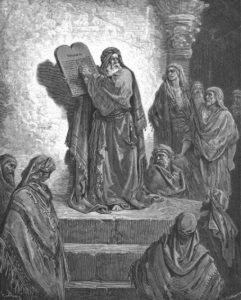
“Ezra reading the Law in the hearing of the people” by Gustav Doré
The Talmud (Bava Kamma 82a) states that Ezra the Scribe made ten decrees upon Israel:
That the Torah be read [publicly] during Minchah on Shabbat; that the Torah be read [publicly] on Mondays and Thursdays; that courts be held on Mondays and Thursdays; that clothes be washed on Thursdays; that garlic be eaten on Fridays; that the housewife rise early to bake bread; that a woman must wear a sinnar; that a woman must comb her hair before performing immersion [in a mikveh]; that merchants be allowed to travel about in the towns, He also decreed immersion to be required by those to whom “pollution” has happened.
One of Ezra’s pronouncements was that women should wear a sinnar in the interests of modesty. Rashi comments here that a “sinnar” is like michnasaim, “pants”. Apparently, pants might be more modest than skirts.
Modesty and Halacha
Perhaps the major issue of wearing pants is that of pisuk raglaim, “separating the legs”. It is immodest for a woman to do so, and this has implications in a range of areas, particularly in horseback riding, which is discussed in the Talmud (Pesachim 3a). While the Sages suggest that a woman should ride a horse, camel, or donkey by sitting side-saddle, it goes on to quote verses from the Torah which clearly depict women, including Rebecca and Tzipporah, riding in the regular way. The Talmud concludes that this is because of “fear”. They were afraid to ride side-saddle, whether because of the animals, or of the night, or some other reason. There is no clear conclusion to the passage, with two of the disciples throwing in the towel and saying the discussion has drained all their energy.
Various halachic sources use pisuk raglaim as a key proof that pants are forbidden for women to wear, since they cause a separation of the legs. Others point out that pants are only a problem if they are tight-fitting, making a clear, visible “separation of legs”. So, loose pants might be permissible. It is said that Rabbi Yosef Eliyahu Henkin (1881-1973) permitted loose pants. His grandson, Rabbi Yehuda Herzl Henkin, shows that pisuk raglaim only refers to spreading legs in a sexual nature (as in Ezekiel 16:25, where the term originates). It has nothing to do with wearing pants—or even horseback riding, for that matter. (See his Bnei Banim, Vol. 4, Siman 28, Passage 6). Meanwhile, Rav Ovadia Yosef (1920-2013) ruled that it is sometimes better for women to wear loose pants than tight or short skirts (Yabia Omer, Vol. 4, on Yoreh De’ah 14).
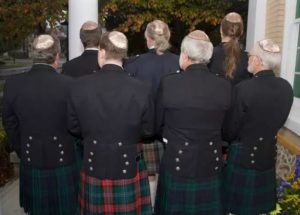
In Scotland, it is still customary to wear a kilt to a wedding. Jews in Scotland wear kilts, too. (Credit: Brian at XMarksTheScot.com)
Finally, pants are not considered exclusively for men in today’s society. Women are just as likely to wear pants as men are. A woman that wears pants, even in public, does not set off any alarms in the public eye, just as a man wearing a kilt—skirt—in 18th century Scotland wouldn’t stand out. Much depends on the surrounding society and culture. Today, Jewish men are forbidden from wearing skirts or dresses, but in ancient times it was common for them to wear skirt-like and dress-like garments. This is illustrated in the Torah itself, which warns that the altar should have ramps instead of stairs, so that the priests would not have to lift their legs and expose themselves (Exodus 20:22). There were no pants or underwear in Biblical times after all.
While mainstream society should not dictate our modesty standards, it nonetheless plays a role. And while every Jewish woman (and man) must still prioritize utmost modesty, a woman who chooses to occasionally wear loose pants (especially in situations where skirts would be uncomfortable or inappropriate like, for example, horseback riding) certainly has upon whom to rely.
For more on pisuk raglaim and the modesty of pants, see here:
http://parsha.blogspot.com/2008/08/would-rashi-necessarily-condemn-pants.html
http://parsha.blogspot.com/2008/08/does-gemara-in-nedarim-prohibit-close.html

